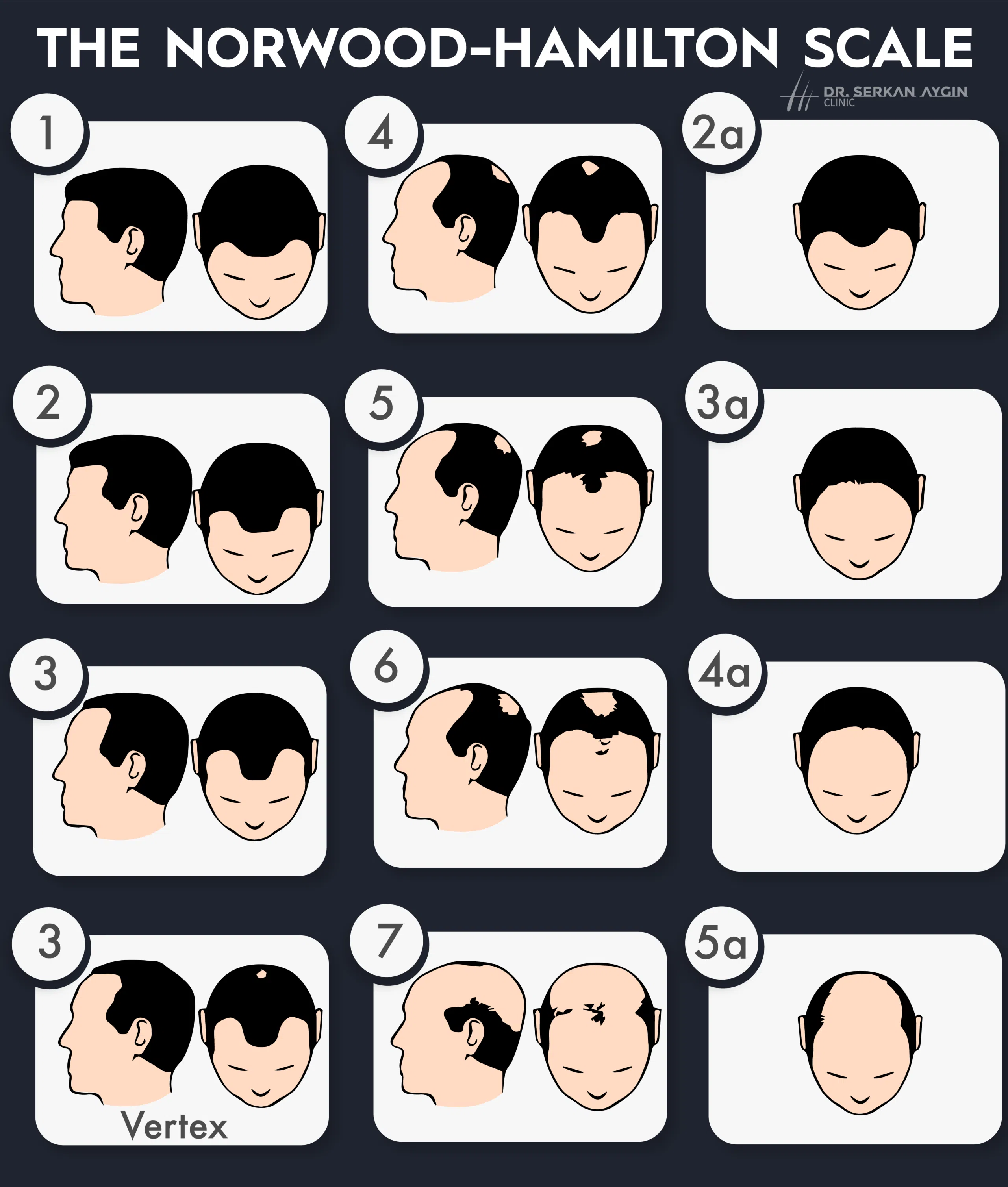The short answer to the question can you get a hair transplant if you are completely bald is no. Since there wouldn’t be enough of a supply of donor hair to place in your recipient areas, unfortunately you cannot get a hair transplant.
But keep in mind that there are several causes and levels of hair loss. Although transplantation is usually not possible for hair loss above 6 on the Norwood-Hamilton scale, there could be exceptions depending on the unique conditions of each candidate.
It is imperative to find out the underlying reasons in order to evaluate your options for hair restoration. You can look into alternative treatments if your baldness is caused by:
- ALOPECIA AREATA
- ALOPECIA TOTALIS
- ALOPECIA UNIVERSALIS
- ALOPECIA CAUSED BY AUTOIMMUNE DISEASES
- CHEMOTHERAPY
- HORMONAL IMBALANCES SUCH AS THYROID DISEASES OR PREGNANCY
Here are some of the key points we mentioned in the article:
- YOU CANNOT GET A HAIR TRANSPLANT IF YOU’RE COMPLETELY BALD.
- VARYING MEDICAL CONDITIONS, INCLUDING GENETIC AND AUTOIMMUNE DISEASES, MAY LEAD TO PEOPLE BECOMING BALD.
- THE LEVEL OF HAIR LOSS DETERMINES WHICH HAIR TRANSPLANTATION PROCEDURES WILL BE FOLLOWED.
- BODY TO HEAD TRANSPLANT IS POSSIBLE, IF YOU HAVE NOT ENOUGH DONOR HAIR ON THE SCALP
Can Hair Transplant Cure Baldness?
No, a hair transplant cannot cure progressive hair loss but it is a very effective way of utilizing native hair to achieve natural-looking and denser hair.
Can You Get A Hair Transplant If You Are Completely Bald On Top?
Yes, most progressive hair loss patients are good candidates for hair restoration. The outlook after hair transplant for these patients is very positive, although the satisfaction rates may depend on hair density.
Additionally, these patients may benefit from non-scalp hair transplant or body hair transplant based on their hair loss condition.
Can You Get A Hair Transplant If You're Bald On The Sides?
No, the conditions that cause balding on the parietal and occipital parts of the head (sides of the head and right above the nape) cannot be reverted with hair transplant procedures. Patients should look into other treatments, such as hair loss medications, to protect their native hair.
Can You Get A Hair Transplant If Your Hair Density Is Low?
Yes, you may get a hair transplant if your hair density is low. Keep in mind that your hair won’t be as voluminous as it was before the hair loss. In the case that your existing hair follicles aren’t enough to cover the bald areas, your hair specialist may advise you to give up surgery completely.
Am I Too Bald For A Hair Transplant? Assessing Suitability For A Hair Transplant
Check out the table below to quickly see if you meet enough conditions to get hair transplant if you’re completely bald.
CAN GET HAIR TRANSPLANT | CANNOT GET HAIR TRANSPLANT |
Below Norwood 6 on hair loss scale | Above Norwood 6 in hair loss scale |
Still has enough follicular units | Doesn’t have enough follicular units |
Safe donor area isn’t afflicted with hair loss | Safe donor area is afflicted with hair loss |
Has androgenetic alopecia | Going through chemotherapy or pregnancy |
Hair loss is patterned | Hair loss is unpatterned |
Recipient area is average | Recipient area is too wide |
A hair transplant expert can assess your level of hair loss and evaluate balding treatment options. The process looks different for every candidate for hair restoration and the methods depend on the type of hair loss. If you’re below Norwood 6 on the hair loss scale you’re not too bald to get hair transplant surgery.
The progression and the causes of baldness can be determined at a clinic with tests such as:
- SCALP BIOPSY
- TRICHOSCOPY
- PULL TEST
- PLUCK TEST
- DAILY STRAND COUNT
The candidates for hair transplantation that classify higher than Norwood 6 might benefit from beard hair or body hair transplantation if the safe donor area cannot provide enough grafts. The density of implanted hair grafts may not cover the recipient area completely if the degree of hair loss is severe.
Understanding Complete Baldness And Its Variations
Baldness is the loss of hair completely either on the entire scalp or in some regions of the scalp. Balding on the top and crown of the head typically occurs due to androgenetic alopecia (or male pattern hair loss) whereas hair loss on the sides of the head can have varying causes such as alopecia areata. While androgenetic alopecia spares the donor area, other forms of alopecia can affect it, rendering hair transplants impossible without a healthy donor site.
Types of hair loss and level of hair loss of a patient depend on several reasons and vary from person to person:
- HAIR FOLLICLE LOSS DUE TO SCARRING (I.E. BURN, SURGERY, ETC.)
- AUTOIMMUNE DISEASES SUCH AS ALOPECIA AREATA OR ALOPECIA UNIVERSALIS
- HORMONAL PROBLEMS SUCH AS PCOS, OR THYROID ISSUES
- COMPLICATIONS AFTER A BAD HAIR TRANSPLANT
- SHOCK LOSS FOLLICULAR UNITS GO THROUGH AFTER HAIR REPLACEMENT SURGERY
- TRICHOTILLOMANIA
- ANAGEN EFFLUVIUM CAUSED BY CHEMOTHERAPY TREATMENT
A medical problem that causes the patient’s natural hair to fall will surely cause the transplanted hair to fall as well. That’s why it’s vital to define the hair loss patterns and determine the underlying causes.
If you’re unsure, it’s time to check in with a hair transplant specialist to get your own customized treatment plan.
What Are The Stages Of Baldness?
There are 7 stages of male pattern baldness, defined by Dr. James Hamilton in the 1950s and updated by Dr. O’tar Norwood in 1975.

- Type 1: Hairline lies on the forehead and the sides haven’t started receding.
- Type 2: There are small triangular areas of recession on the front.
- Type 3: Unclassified types of hair loss are gathered.
- Type 4: This is the minimal amount of hair loss considered sufficient to represent baldness. The receding areas on the front have deepened, and the scalp is sparsely covered or bare.
- Type 5: There are extensive frontal recessions with no hair on the crown.
- Type 6: The crown of the head remains bare and there’s an ‘island’ forming in the front of the hairline.
- Type 7: The sides and back have taken the shape of a horseshoe. The crown, above the forehead, and the frontoparietal areas are entirely bare.
There are 3 stages of female pattern baldness defined by Dr. E. Ludwig in 1977.
- Grade I: The crown has started to thin but the frontal hairline hasn’t receded more than 3 cm yet.
- Grade II: Thinning continues on and around the parting.
- Grade III: Complete baldness in the affected area.
Can I Get A Hair Transplant After Getting Alternative Treatments?
Since alternative hair loss treatments target the existing supply of hair and protect the hair at risk, they won’t help you gain new hair follicles. If you’ve lost your native hair follicles in the safe donor area, a hair transplant is not possible.
REFERENCES
[1] Zito, Patrick M. and Blake S. Raggio. “Hair Transplantation.” StatPearls, StatPearls Publishing, 14 February 2023.
[2] Gupta, Mrinal, and Venkataram Mysore. “Classifications of Patterned Hair Loss: A Review.” Journal of cutaneous and aesthetic surgery vol. 9,1 (2016): 3-12. doi:10.4103/0974-2077.178536
[3] Phillips, T Grant et al. “Hair Loss: Common Causes and Treatment.” American family physician vol. 96,6 (2017): 371-378.
[4] Avci, Pinar et al. “Low-level laser (light) therapy (LLLT) for treatment of hair loss.” Lasers in surgery and medicine vol. 46,2 (2014): 144-51. doi:10.1002/lsm.22170
[5] A. K. Gupta, M. Talukder, M. Venkataraman & M. A. Bamimore (2022) Minoxidil: a comprehensive review, Journal of Dermatological Treatment, 33:4, 1896-1906, DOI: 10.1080/09546634.2021.1945527
[6] Iamsumang, Wimolsiri et al. “Finasteride and Its Potential for the Treatment of Female Pattern Hair Loss: Evidence to Date.” Drug design, development and therapy vol. 14 951-959. 2 Mar. 2020, doi:10.2147/DDDT.S240615
[7] Rose, Paul T. “Hair restoration surgery: challenges and solutions.” Clinical, cosmetic and investigational dermatology vol. 8 361-70. 15 Jul. 2015, doi:10.2147/CCID.S53980

